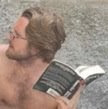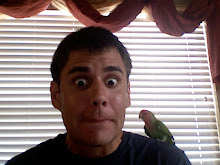Moses descended from Mount Sinai with two stone tablets in hand, and happened upon the scene of the greatest act of blasphemy in human history. The Israelites had given up their finest jewelry for Aaron to melt down and fashion into a golden calf. It was a beautiful calf, the people were pleased, and they said, "These be thy gods, O Israel, which brought thee up out of the land of Egypt." It looked exactly like this:

Moses, who, as we all know, wrote the book of Exodus in real time, as it was happening (this is how he managed to write his own epitaph - he wrote it as he was dying), had only to scroll back to Chapter 20, verses 2-3, to perceive that something was awry: "I am the LORD thy God, which have brought thee out of the land of Egypt, out of the house of bondage. Thou shalt have no other gods before me." Moses did an on-the-fly synchronic textual analysis of this commandment and the Israelites' above-quoted pronouncement, and identified the polar opposition between the two. Aaron and the Israelites almost seemed to have gone out of their way to invert the First Commandment word for word. Moses was indignant, and he looked exactly like this:

We tend to have either of two reactions to this. Aaron and the Israelites either had a terrible memory, and simply couldn't remember the First Commandment, or Aaron was a great blasphemer who wanted to Stick It To The Man for making them wait so long in the desert.
Then we read a bit more carefully and see that Aaron was a righteous man, and he evidently had the makings of a good pastor. Right after the erection of the calf, Scripture reads, "And when Aaron saw it, he built an altar before it; and Aaron made proclamation, and said, To morrow is a feast to the LORD." The golden calf was raised up in the name of the Lord. The people, weary of merely hearing of God's promises, needed a concrete way to see and experience their God, who was distant from them. Aaron gave them the calf as a visual and imaginative aid to their conception of YHWH, as a sign of hope that their God was real and would fulfill his covenant with them. While this was a good move pastorally for Aaron, he was out of step theologically: In Egypt the Israelites would have been accustomed to seeing grand idols in the Egyptian gods' honor, so showing the grandness of Israel's God through a golden idol would have, in some sense, legitimized YHWH in their eyes. However, YHWH was the imageless God, the God beyond all materiality and all understanding, and Moses knew this. YHWH could not be contained in any human categories, could not be emulated visually, indeed, could not even be named.
We've all heard this before. But here is where I think it gets interesting. (This is an explicitly theological-philosophical reading, not an attempt to capture the "original intent" of the text, pace trained biblical exegetes.) Moses descended Mount Sinai with the two stone tablets - the Very Word of God - in hand, and suddenly realized he was complicit in their sin. The tablets he carried were in effect authoritative representations of God's own will, God's own intentionality. He understood this, and had to act:
And it came to pass, as soon as he came nigh unto the camp, that he saw the calf, and the dancing: and Moses' anger waxed hot, and he cast the tables out of his hands, and brake them beneath the mount.
Moses and Aaron represent the twin modes of understanding God: Aaron embodies the power of the image, of the phenomenal manifestation of the divine in the physical world; Moses stands for the ideality of God, the law, the words that create understanding of an invisible and unimaginable God. Both men are in the business of bearing and communicating the divine in human categories so that their people may believe. Moses recognized the people's proclivity for idolatry and understood that, if the golden calf had to be dismantled and burned, the tablets must be broken also. The idea of an original set of tablets, an original inscription of God's very words, simply carried too much potential for idolatry. So he smashed them against the rocks and wrote a second copy, so that all would know that the best we can lay claim to is a copy, which is really a copy of a copy.
Which is really a copy of a copy of a copy, right? Moses' breaking of the stones was a symbolic act, the function of which was to underscore the unattainableness of any kind of original foundation that we can confidently seize and claim as our own. Umberto Eco supposedly said somewhere that the universe is like an onion, and an onion is all peel. You peel back layers trying to find a core, but what you get are more layers. We try to peel back the layers of church history to find the "true Christian community" in the primitive church, and then we see that the early church was riddled with problems, and probably didn't have the kind of robust theology we'd like to credit them with. Then we try to peel back layers of Paul's letters to find the manuscripts that contain the best representation of the Apostle's "original intent", and then we realize that he's reflecting on his experience of seeing Christ. So we take it to the gospels. But after enough layer-peeling we realize that it is impossible to access the man of Jesus independent of a shroud of texts - texts layered over texts layered over texts. Matthew and Luke are layered over Mark, Mark's account was layered over Peter's testimony, Peter's testimony is layered with his cultural and historical assumptions (an "archi-text", if you will).
This is not to say that theology is ultimately meaningless since there's no escape from the endless layer-peeling. It is to say, however, that theology is to be found in the layers, in the shifting sands of our finite knowledge. It is the discomfort with layers that results in all our incessant calf-building - materialism, nationalism, humanism, fundamentalism, scientism, individualism, and, the most difficult golden calf to dismantle, our understanding. The orgiastic Israelites at the foot of Mt. Sinai suddenly look much different when we identify ourselves in them. We are uncomfortable with the uncertainty, the wandering in the desert, the waiting for Moses to descend from the mountain and deliver the goods. Moses will arrive, eventually, and when he does we might be disappointed to find that all he carries are broken tablets, tablets that only defer to what is beyond and behind them, that is, the One who is beyond all names.
...
And the LORD passed by before him, and proclaimed, The LORD, The LORD God, merciful and gracious, longsuffering, and abundant in goodness and truth, keeping mercy for thousands, forgiving iniquity and transgression and sin, and that will by no means clear the guilty; visiting the iniquity of the fathers upon the children, and upon the children's children, unto the third and to the fourth generation.
Exodus 34:6-7





